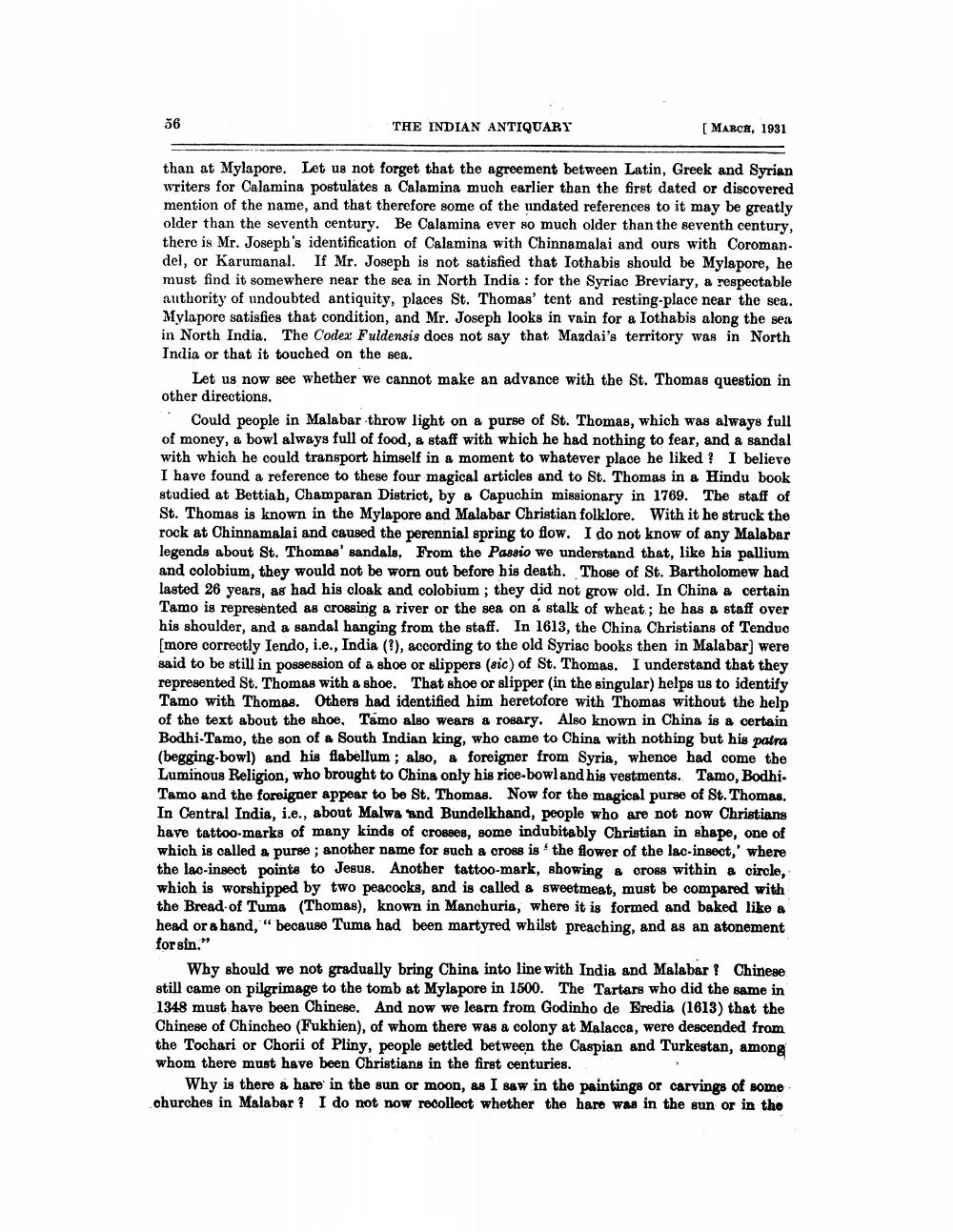________________
36
THE INDIAN ANTIQUARY
[MARC#, 1931
than at Mylapore. Let us not forget that the agreement between Latin, Greek and Syrian writers for Calamina postulates a Calamina much earlier than the first dated or discovered mention of the name, and that therefore some of the undated references to it may be greatly older than the seventh century. Be Calamina ever so much older than the seventh century, there is Mr. Joseph's identification of Calamina with Chinnamalai and ours with Coroman. del, or Karumanal. If Mr. Joseph is not satisfied that Iothabis should be Mylapore, he must find it somewhere near the sea in North India : for the Syriac Breviary, a respectable authority of undoubted antiquity, places St. Thomas' tent and resting-place near the sea. Mylapore satisfies that condition, and Mr. Joseph looks in vain for a lothabis along the sea in North India. The Codex Fuldensis does not say that Mazdai's territory was in North India or that it touched on the sea.
Let us now see whether we cannot make an advance with the St. Thomas question in other directions. * Could people in Malabar throw light on a purse of St. Thomas, which was always full of money, a bowl always full of food, & staff with which he had nothing to fear, and a sandal with which he could transport himself in a moment to whatever place he liked ? I believe I have found a reference to these four magical articles and to St. Thomas in a Hindu book studied at Bettiah, Champaran District, by a Capuchin missionary in 1769. The staff of St. Thomas is known in the Mylapore and Malabar Christian folklore. With it he struck the rock at Chinnamalai and caused the perennial spring to flow. I do not know of any Malabar legends about St. Thomas' sandals. From the Passio we understand that, like his pallium and colobium, they would not be worn out before his death. Those of St. Bartholomew had lasted 26 years, as had his cloak and colobium ; they did not grow old. In China a certain Tamo is represented as crossing a river or the sea on a stalk of wheat; he has a staff over his shoulder, and a sandal hanging from the staff. In 1613, the China Christians of Tenduo [more correctly lendo, i.e., India (?), according to the old Syriac books then in Malabar) were said to be still in possession of a shoe or slippers (sic) of St. Thomas. I understand that they represented St. Thomas with a shoe. That shoe or slipper (in the singular) helps us to identify Tamo with Thomas. Others had identified him heretofore with Thomas without the help of the text about the shoe. Tamo also wears a rosary. Also known in China is a certain Bodhi-Tamo, the son of a South Indian king, who came to China with nothing but his patra (begging-bowl) and his flabellum ; also, a foreigner from Syria, whence had come the Luminous Religion, who brought to China only his rice-bowland his vestments. Tamo, Bodhi. Tamo and the foreigner appear to be St. Thomas. Now for the magical purge of St. Thomas. In Central India, i.e., about Malwa and Bundelkhand, people who are not now Christians have tattoo-marks of many kinds of crosses, some indubitably Christian in shape, one of which is called a purse ; another name for such a cross is the flower of the lac-insect,' where the lac-insect points to Jesus. Another tattoo-mark, showing a cross within a circle, which is worshipped by two peacocks, and is called a sweetmeat, must be compared with the Bread of Tuma (Thomas), known in Manchuria, where it is formed and baked like a head or a hand,'" because Tuma had been martyred whilst preaching, and as an atonement for sin."
Why should we not gradually bring China into line with India and Malabar ? Chinese still came on pilgrimage to the tomb at Mylapore in 1500. The Tartars who did the same in 1348 must have been Chinese. And now we learn from Godinho de Eredia (1613) that the Chinese of Chincheo (Fukhien), of whom there was a colony at Malacca, were descended from the Tochari or Chorii of Pliny, people settled between the Caspian and Turkestan, among whom there must have been Christians in the first centuries.
Why is there a hare in the sun or moon, as I saw in the paintings or carvings of some churches in Malabar? I do not now recollect whether the hare was in the sun or in the




